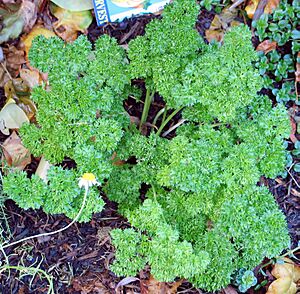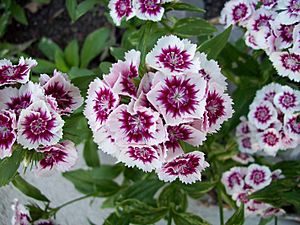Biennial facts for kids
A biennial plant is a type of flowering plant that needs two years to finish its entire life. In the first year, the plant grows its leaves, stems, and roots. These are called vegetative parts. Then, it rests during the colder months, a period known as dormancy.
Usually, the stem stays very short, and the leaves grow close to the ground, forming a shape like a flat rose, called a rosette. Many biennial plants need to experience cold weather before they can produce flowers. In the next spring or summer, the plant's stem grows much longer. After that, the plant flowers, makes fruits and seeds, and then it dies. There are fewer biennial plants compared to perennials (plants that live for many years) or annuals (plants that live for one year).
Contents
What Makes a Biennial Plant Special?
Sometimes, if the weather is very extreme, a biennial plant might finish its life cycle much faster. This could happen in just 3 or 4 months instead of two years. This is common for vegetable or flower seedlings that were exposed to cold before being planted. Because of this, many plants that are normally biennials are sometimes grown as if they were annuals in certain places.
Biennials in Your Garden
For gardeners, whether a plant is an annual, biennial, or perennial can change depending on where it's grown or what it's used for.
- For Flowers, Fruits, or Seeds: If you want a biennial plant for its flowers, fruits, or seeds, you need to grow it for two years.
- For Leaves or Roots: If you grow biennials for their edible leaves or roots, like beets, Brussels sprouts, cabbage, carrots, celery, parsley, and Swiss chard, they are often grown as annuals. This means you harvest them in their first year before they flower.
- Harsh Conditions: If a biennial plant grows in very tough conditions, it might be treated as an annual. This is because it might not survive the cold winter to flower in the second year.
- Short-Lived Perennials: Some plants that are actually perennials (meaning they live for more than two years) might seem like biennials because they don't live very long. The main difference is that true biennials only flower once, while many perennials flower every year once they are grown up.
Examples of Biennial Plants
You might know some common biennial plants! Here are a few:
- Parsley
- Lunaria (also known as Honesty)
- Silverbeet
- Sweet William
- Colic weed
- Carrot
The pansy is a biennial plant that is often grown as an annual. Plant breeders have also created special types of biennials that will flower in their very first year from seed. Examples include foxglove, stock, and hollyhock.
Can Biennials Live Longer?
It is possible to keep biennial plants alive for more than two years. This happens if the environment prevents them from flowering. For example, a biennial sugar beet plant was kept alive in a greenhouse for 41 months (over three years!) because it was not given the cold treatment it needed to flower.
See also
 In Spanish: Bienal para niños
In Spanish: Bienal para niños



